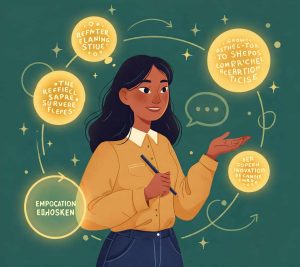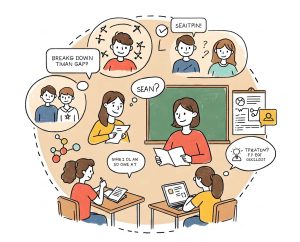In an ever-evolving landscape, the role of language educators is undergoing a transformation. Whether we like it or not, roles are changing, disintegrating, and evolving – take your pick. Language teachers today are not just imparting linguistic skills; they’re shaping students for the careers of the future. I’ll be offering a short exploration of how Artificial Intelligence (AI) is revolutionizing language education, bridging language fluency with professional readiness.
And yes, I am using AI to brainstorm this rich theme.
What does the future classroom look like anyway? Is it a place where your students learn to seamlessly negotiate international business, compose compelling digital content, and collaborate virtually across borders? The integration of AI in language education can open doors to such a future. From personalized learning paths that cater to individual career goals to AI-generated real-world simulations that immerse learners in professional scenarios, the potential is both promising and expansive. And frightening – understood.
Let’s see how AI identifies emerging industry trends, tailors content to specific professions, and nurtures cross-cultural communication skills. This article looks into not only “how” AI facilitates this transformation but also the essential role of human connection in preserving the true foundations of language education.
For language teachers, the concept of AI identifying emerging trends and suggesting relevant areas of study for future careers can be interpreted in several ways. Here’s how AI could be applied in the context of language teaching.
1. Career-specific language skills: AI can analyze job market trends and identify industries or professions that are in demand. Language teachers can then tailor language lessons to include vocabulary, phrases, and communication skills that are directly relevant to those industries.
Top tip: if AI predicts a growing need for English-speaking professionals in the field of renewable energy, language teachers could focus on teaching technical vocabulary related to this sector.
2. Customized learning paths: AI can assess individual learners’ interests, skills, and career aspirations. Based on this information, it can create personalized learning paths that prioritize language skills and topics relevant to their desired careers.
Top tip: if a student expresses interest in international marketing, the AI-powered platform could emphasize business communication and cross-cultural communication skills.
3. Real-world scenarios and simulations: AI can generate realistic scenarios and simulations based on current industry trends. Language learners can practise conversations, negotiations, and presentations in contexts that mirror their future career settings. This approach can help students gain confidence and fluency in using language in professional contexts.
Top tip: Language learners pursuing a career in international sales can participate in AI-driven simulations where they negotiate a complex deal with virtual counterparts from diverse cultures, honing their language skills while navigating real-world business challenges.
4. Content curation: AI can curate and recommend relevant articles, podcasts, videos, and case studies related to emerging trends in various industries. Language teachers can integrate this curated content into their lessons, allowing students to engage with authentic materials and stay updated on their chosen career fields.
Top tip: an AI-powered platform could identify a language learner’s interest in sustainable fashion and curate a selection of articles, videos, and expert interviews on eco-friendly textiles and ethical manufacturing practices, enriching language lessons with industry-specific content that aligns with the learner’s career aspirations.
5. Collaboration with industry experts: AI can build and offer connections between language learners and industry experts. Virtual meetings or Q&A sessions with professionals from specific fields can expose learners to real-world language usage and terminology while fostering networking opportunities.
Top tip: a language learner interested in culinary arts could virtually engage in a Q&A session with a renowned chef, discussing gastronomic trends, recipe innovation, and restaurant management in a language-immersive environment, thereby gaining insights and language fluency relevant to their career pursuit.
6. Language for remote work and digital communication: As remote work and digital communication become more prevalent, AI can help language teachers focus on teaching skills related to online collaboration, virtual presentations, and effective communication through digital platforms.
Top tip: in adapting to the digital era, a secondary school language teacher could leverage AI to guide students in simulating online debates on global issues, enhancing their language proficiency while fostering critical thinking and respectful virtual communication within a remote learning environment.
7. Language for Artificial Intelligence and technology fields: AI itself is a growing field, and language teachers can prepare students for roles related to natural language processing, machine translation, and AI-driven content creation. Teaching language skills that are valuable in the AI and technology sectors can open up new career opportunities. As AI’s influence expands, language educators can equip students for AI-related roles.
Top tip: by immersing language learners in projects where they create AI-generated content for, let’s say virtual assistants, teachers can simultaneously hone their language skills and understanding of AI applications in content creation, setting the stage for diverse career paths such as AI-driven marketing or virtual customer support.
It’s important for language teachers to collaborate with AI developers and ensure that AI-driven tools are aligned with their teaching objectives, respect cultural nuances, and maintain a strong focus on human interaction and communication skills.
Learning coaching skills can seamlessly complement the exploration of AI possibilities in the language classroom, empowering language teachers to guide students in not only mastering linguistic proficiency but also navigating the ever-evolving digital landscape. This synergy allows educators to facilitate self-directed learning, helping students leverage AI tools effectively, make informed decisions about language resources, and ultimately help autonomous learners ready to adapt to emerging language and technology trends.
This article comes to you via The International Language Coaching Association, written by Gabriella Kovács MA, PCC
Source: https://www.linkedin.com/pulse/navigating-tomorrow-ais-influence-language






